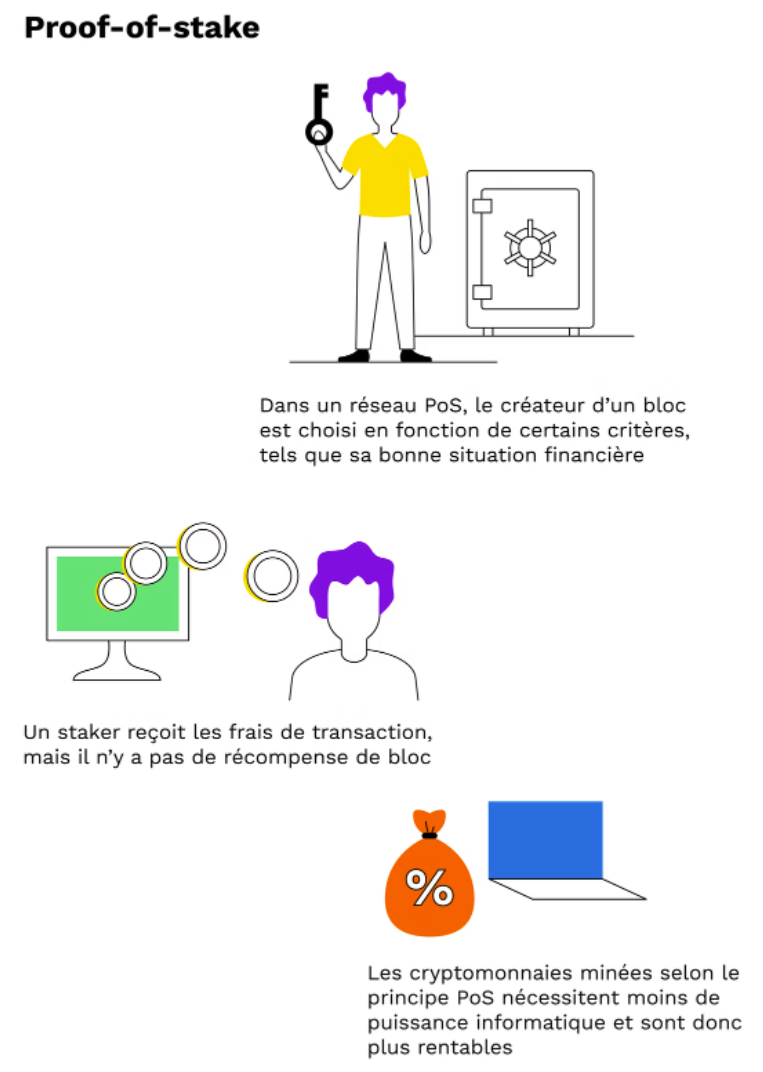As a preamble, I would like to specify the term “room” because I will use it regularly in the rest of this episode. Coins represent a certain amount of cryptocurrency.
For example :
Amount of ETH in your wallet: 0.235 ETH
On the one hand, if you sell them today, we can consider that you are “recirculating your ETH coins (0.235 ETH) in the network”. On the other hand, if you hold ether in your wallet, we could say that “you keep your ETH coins in your wallet”. Coins are therefore a certain amount of cryptocurrency. Now that we are more comfortable with the term “coin” (a unit of cryptocurrency), let’s dive into the discovery of the proof-of-stake protocol.
The goal of consensus algorithms, whether proof-of-work or proof-of-stake, is indeed to verify that transactions are genuine and valid. It is also a question of verifying that the actors act correctly and cannot defraud while ensuring maximum decentralization of the system. But in the context of proof of stake, how does it work?
“Proof of Stake? How it works ?”
To validate transactions via proof of stake mining, it is necessary for the owners to offer their coins as collateral, in other words, that they are in escrow on the network, to have the possibility of validating the blocks and thus becoming validator. We therefore understand that it is necessary to hold a certain amount of cryptocurrencies which are stored on the network.
“A certain amount of cryptocurrencies blocked? That is to say ?”
In the case of Ethereum for example, and as part of its future migration from current proof of work to proof of stake, it will be necessary to hold at least 32 ETH (i.e. at the current price more than $120,000) to becoming a validator on the network, in other words, it is not within the reach of all budgets. We already see, here, a certain form of centralization looming on the horizon, since strong financial barriers are now positioned at the entrance.
“But is this proof of stake new?”
Proof of stake first appeared in 2013 as an alternative to proof of work, which was democratized four years earlier by bitcoin. Although a large majority of cryptocurrencies use the proof-of-work model, some of them have preferred to go directly to proof-of-stake. One could, for example, cite Cardano and Solana which have been anchored for many months in the Top 10 of the market in terms of market capitalization. And as mentioned earlier, Ethereum should soon join them.
“But in practice, what really differs between proof of stake and proof of work?”
Proof of work relies, to put it simply and succinctly, on the computing power of miners (computers connected to the network) to secure the blockchain and ensure that individuals act correctly. In the context of proof of stake, we no longer speak of “miners” but rather of “participants” or “validators”. Concretely, these actors will “staker” in the Anglo-Saxon version, or “staking/locking” in French, their crypto-assets to become validators on the network.
As part of the proof of work, as its name suggests, miners must prove their “work” with the computing power of their computer hardware (materialized by the hash rate, a complex mathematical function allowing to validate the blocks ), while here, participants must prove their “stake” with the locking of a certain number of cryptocurrencies (materialized by a certain number of coins blocked on the network). Thus, the algorithms randomly determine, among the validators who have “staked” their coins, which one will integrate the next block of transactions.
Proof of Work vs Proof of Stake
leewayhertz.com
“But in proof of stake, how are the famous validators paid?”
There is therefore an important nuance between proof of stake and proof of work:
- For proof of work, as with Bitcoin for example, miners receive a certain number of coins as a reward for their contribution to securing the network. Typically, in the context of Bitcoin, the miner who validates a block will receive 6.25 bitcoins, in other words, a fixed remuneration of cryptocurrencies.
- For Proof of Stake, there are no fixed and precisely determined block rewards. Validators are only rewarded via transaction fees. Participants have a chance of being drawn based on criteria defined by the deterministic algorithm underlying the consensus protocol.
“What? Deterministic algorithm? Kesako?”
Proof-of-stake networks use deterministic algorithms to operate, i.e. validators are chosen, or rather elected, based on the configuration of the underlying algorithms. One could for example choose only validators according to the number of coins they hold in their wallet (like the 32 ETH needed on Ethereum), or even choose only validators who have had coins for X time in their wallet (for example, hold ETH coins for at least 60 days to become a validator). There may also be no conditions to become a validator, i.e. from 1 cent “put into play” and without a time limit, we become a validator, but the probability that you will be drawn greatly decreases. Simply put, if your coins are 0.001% of the total amount of coins that have been locked, then your probability of being chosen as a validator would be approximately 0.001%.

Source: Bitpanda
If I read the infographic above correctly, proof of stake is much less energy intensive than proof of work?”
While proof-of-work requires a large number of computers to operate simultaneously without interruption, consuming a significant amount of energy in the process, this is not the case for proof-of-stake. And yes, you will have understood it, the algorithms will randomly choose the wallets which will have locked coins on the underlying blockchain. A process that requires significantly less consumption than for proof of work. The graph below shows the annual electricity consumption of the Bitcoin and Ethereum network, operating with proof of work, as well as that of the Tezos network, which operates with proof of stake.

Medium.com
It is clear that from a point of power consumption, proof of stake is extremely less energy intensive than proof of work. This decrease is easily understandable because, in this case, it is not necessary for a large number of computers to operate and compete to find consensus on the blockchain.. If the proof of stake is much less energy intensive than the proof of work, everything is still not perfect.
“Proof of stake encourages more centralization?”
In a proof-of-stake network, the more coins a validator holds, the more power they gain. Since it is not necessary to expend energy resources to lock coins in order to become a validator on the network, over the months the validators, by reinjecting the rewards they obtain through their initial “staking” , become stronger and stronger. In other words, they are more and more likely to be the next validators if the underlying deterministic algorithm is configured to take “the amount of coins held in the wallet” as a criterion for making the draws.
Example :
Three validators are on the network:
Validator wallet 1: 20% of coins in circulation
Validator Wallet 2: 25% of coins in circulation
Validator wallet 3: 55% of coins in circulation
Here wallet 3 will tend to be selected more by the proof of stake algorithm. By being rewarded more, and if the coins are reinjected into the wallet in question, it will become more and more powerful and will therefore be more and more chosen by the algorithm since its share (55%) will increase as it goes. . In this context, and we easily understand it, centralization can quickly resurface. A relatively small number of operators, holding huge amounts of coins would become the majority validators.
Let’s summarize the process:
When a block of transactions is ready to be processed by a validator, the protocol, via the deterministic algorithms, of the proof of stake of the cryptocurrency in question will choose a node (a wallet where cryptocurrencies are locked) of validation to examine the block . The validator, thanks to his connected computer, which is drawn by lot, will check, algorithmically, if the transactions are exact. If so, the block is added to the blockchain and the validator receives transaction fees as a reward for contributing to the system. If ever a validator tries to register a block with inaccurate information, he may lose some or all of the locked cryptocurrencies as a penalty.
“But technically, how beneficial is this migration from proof of work to proof of stake for a blockchain?”
For example, as part of the Ethereum migration, power consumption should be reduced by 99% and transaction execution speed should increase from 15 transactions/second to 100,000 transactions/second. At least theoretically. However, the network should potentially become more centralized because, as we have seen, validators with a lot of coins will be more likely to be drawn more than those with a small part.
Strengths and weaknesses :
Proof of Stake:
- Low power consumption
- High transaction execution speed
- Important centralization
Proof of work:
- High power consumption
- Low transaction execution speed
- Significant decentralization
Here we understand that proof of stake is intended to be an interesting alternative to proof of work. Whether in terms of transaction speed or power consumption, there is no debating, proof of stake wins hands down. On the other hand, the fundamental aspect of decentralization raises questions here.
If in proof of work, anyone can contribute to supporting the network by becoming a miner with hardware, this is less the case in proof of stake protocols because barriers to entry can be greater. Thus, and we can verify this with existing protocols, Bitcoin remains, and with a big margin in advance, the most decentralized protocol and therefore the most resistant to attacks. On the other hand, it is relatively slow and consumes a lot of energy.
The choice of consensus mechanism between proof of work and proof of stake is a key factor in the decentralization, efficiency, and security of the network that will support Web 3.0 activities. See you in the next episode to dissect another facet of this technologically exciting universe.
Previous episode: Episode 10: Web 3.0, Bitcoin between waste and overconsumption of energy
